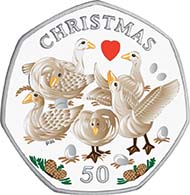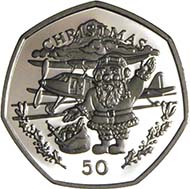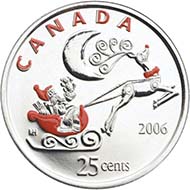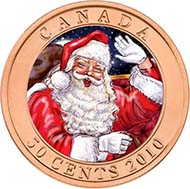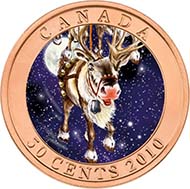December 23, 2010 – The Holiday Season is upon us, a time when we gather in family tradition to share a scrumptious dinner, tell stories… So why not also take advantage of the occasion to share your passion and show off your collection? Why not build a collection of Christmas pieces? Oh yes, many beautiful coins have been struck that commemorate this most celebrated of events we call Christmas.
Christmas – Sacred Holiday, Secular Holiday
Traditionally, Christmas celebrates the solemnity of the Nativity, a Christian commemoration of the birth of Jesus of Nazareth who, according to the Gospels of Matthew and Luke, would be born in Bethlehem. Only the Gospel according to Luke actually tells the story of Christ’s birth. The Gospel according to Matthew traces Christ’s genealogy, only mentioning the birth event in passing, while the Gospels of Mark and John begin their story of Jesus’ life with his meeting of John the Baptist.
In the Anglosaxon region, the Nativity is traditionally celebrated on December 25, at Christmas, but this date is simply a convention and has nothing to do with a “birth day.” The date was likely established by the church in Rome during the 4th century, perhaps in 354, to coincide with the pagan holiday of Sol Invictus, which celebrated the birth of the god Mithra. This choice enabled an assimilation of the coming of Christ “the light of justice” with the rising of the sun following the winter solstice. Prior to this, the Nativity had been celebrated on January 6, as it still is today within the Armenian Apostolic Church, the date on which the Roman Catholic Church celebrates the Epiphany.
In the 21st century, Christmas has also acquired a significant secular aspect. It has become a commercial holiday, a high point in the year that is celebrated even by non-believers. The holiday is characterised by families gathering around the dinner table for a grand meal and by an exchange of gifts, which in many western countries is associated with the figure of Father Christmas or Santa Claus.
Christmas coins
The fact that Christmas coins exist was mentioned earlier, so let’s have a look at a few.
The Isle of Man’s 2010 Christmas coin feature “six geese-a-laying” for the sixth day of Christmas. Source: Pobjoy Mint.
The first coin devoted to this holiday was issued by the Isle of Man in 1980: a 50-penny piece that is seven-sided (heptagonal) and has a 30 mm diameter. Struck in cupro-nickel, sterling silver, gold, and platinum by the Pobjoy Mint, the coin is accessible to all budgets and has been issued annually since the start of the series. During the first ten years, this Christmas coin features typical Holiday scenes from over the years, highlighting various means of transportation, symbolizing family members travelling to gather for the holiday. The only exception is the 1982 piece, which features a huge Christmas tree. During the 1990s, the themes become more traditional: the Nativity, children playing, family scenes, and Christmas stories. In 2000, celebrated Christmas tales, such as Charles Dickens’ A Christmas Carol, start appearing on the coins, with the countdown of the ever-popular English carol The Twelve Days of Christmas in progress since 2005.
The reverse of the 1996 Gibraltar Christmas coin shows Father Christmas getting ready to get into an aeroplane. Source: Serge Pelletier.
The tiny territory of Gibraltar begins issuing an annual Christmas coin in 1988. Since it also has a 50-penny coin, similar to that of the Isle of Man, and because the Pobjoy Mint strikes the territory’s coins, this coin is chosen for the Christmas piece. From 1988 to 1991, classical images are featured: the Three Kings of the Magi, the Virgin Mary, and children. In 1992, Father Christmas appears for the first time on a coin, and continues to appear regularly thereafter, occasionally yielding the place of honour to characters from Christmas tales. Such was the case in 2003 when The Snowman, hero of Raymond Briggs’ 1978 children’s book of the same title, graced the obverse of what was also the first coin in the series available in colour.
The reverse of the 2006 25-cent coin from Canada show a coloured Santa Claus in his sleigh pulled by Rudolph. Source: Royal Canadian Mint.
Canada is also a member of the “Christmas Club.” Since 2004, the Royal Canadian Mint has issued a variety of pieces for the Holiday Season.
The first is a colourized 25-cent piece (i.e., a piece struck with a design in relief which has had paint applied through the process of pad printing) upon which we find none other than Santa Claus, dressed in his red suit and adjusting his spectacles. The next year features a red Christmas stocking stuffed with a fuzzy Teddy Bear. Santa Claus returns in 2006, this time in his sleigh pulled by a single reindeer, with several red accents adding colour.
The Christmas 25-cent collection continues in 2007 with a multi-coloured, two-dimensional design of a decorated Christmas tree painted directly on the reverse field of the coin, i.e., no relief. The 2008 coin features a photograph of Santa’s head. Santa is also represented on subsequent coins, but in drawing. All these coins have the same characteristics as the circulation 25-cent pieces, i.e., struck on nickel-plated steel, 23.88 mm in diameter, and a weight of 4.40 g.
The reverse of the 2010 50-cent lenticular piece from Canada alternates from an image of Santa to one of Rudolph the red-nosed reindeer. Source: Royal Canadian Mint.
The Royal Canadian Mint introduces a new Christmas series in 2007 that features lenticular (that shows a three-dimensional image) 50-cent coins. Larger than regular 50-cent coins, they are 35.00 mm in diameter, with a weight of 12.61 g. Made of brass-plated steel, they have a lovely golden colour. The first piece features a large field of decorative Christmas balls on a tree; the second (2008) features a snowman; and the third (2009) shows a toy train underneath the Christmas tree. This year’s coin employs two images: one with Rudolph the red-nosed reindeer; and the other with Santa Claus in his sleigh, waving Merry Christmas to all.
This charming 4-dollar coin from Canada shows kids hanging their stockings on the mantle of the chimney. Source: Royal Canadian Mint.
Silver coins are also issued. In 2009, a 4-dollar coin in fine silver features children hanging their Christmas stockings over the fireplace. A 20-dollar coin, dated 2007, features an old French-Canadian tradition – friends enjoying a holiday sleigh ride, while the piece from 2008 shows Christmas carol singers, an old English tradition.
The superb Christmas star from Niue, produced by the Polish Mint, shows kids opening their presents in front of a Christmas tree decorated with three zircons. Source: Mennica Polska.
Why not add the new silver 1-dollar coin from Niue called “the Christmas star”? Struck from sterling silver, this gorgeous piece is shaped like a seven-pointed star, is 44.00 mm in diameter and weighs 28.28 g. The reverse features kids opening their gifts in front of a Christmas tree. The tree is decorated with three zircons.
All these pieces make excellent gifts.
by Serge Pelletier
The original was published in the Nov/Dec issue of moneta, the electronic journal of the Ottawa Coin Club.
If you want to know more about the Ottawa Coin Club, please click here.




